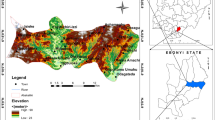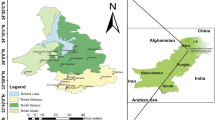Abstract
Groundwater is the main source of water in arid regions. Thus, groundwater pollution becomes a major issue due to the increasing contamination, which poses serious and harmful risk to the environment. Groundwater vulnerability maps can be used as a tool to help decision makers to protect groundwater resources from contamination. The vulnerability of the Mio-Plio-Quaternary shallow aquifer (Southeast Tunisia) has been assessed using a DRASTIC model based on Geographic Information System (GIS). The different parameters of the model were collected from several sources and converted into thematic maps using ArcGis©. Each DRASTIC parameter was assigned a weight and rating based on a range of information within the parameter. Groundwater vulnerability map shows a large area (48%) with high risk of pollution. It indicates that the Southern part of the aquifer and the wadi beds are the most susceptible to contamination. The measured nitrate concentration is coherent with the DRASTIC model results.
Similar content being viewed by others
References
Ahmed, I., Nazzal, Y., Zaidi, F.K., Al-Arifi, N.S.N., Ghrefat, H., and Naeem, M., Hydrogeological vulnerability and pollution risk mapping of the Saq and overlying aquifers using the DRASTIC model and GIS techniques, NWSaudi Arabia, Environ. Earth Sci., 2005. doi 10.1007/s12665-015-4120-5
Albinet, M. and Margat, J, Cartographie de la vulnérabilitéà lapollution des nappes d’eau souterraine (Mapping of groundwater vulnerability to contamination), Bull. BRGM, 1970, vol. 2, no. 4, pp. 13–22.
Aller, L., Bennet, T., Leher, J.H., Petty, R.J., and Hackett, G., DRASTIC: A Standardized System for Evaluating Ground Water Pollution Potential Using Hydrogeological Settings, 1987, EPA 600/2-87-035, p. 622.
Alwathaf, Y. and El Mansouri, B, Assessment of aquifer vulnerability based on GIS and ARCGIS methods: A case study of the Sana’a Basin (Yemen), J. Water Resour. Prot., 2011, vol. 3, pp. 845–855.
Aydi, W., Saidi, S., Chalbaoui, M., Chaibi, S., and Ben Dhia, H, Evaluation of the groundwater vulnerability to pollution using an intrinsic and a specific method in a GIS environment: Application to the plain of Sidi Bouzid (Central Tunisia), Arab. J. Sci. Eng., 2013, vol. 38, pp. 1815–1831. doi 10.1007/s13369-012- 0417-9
Babiker, I.S., Mohamed, A.A., Hiyama, T., and Kato, K., A GIS based DRASTIC model for assessing aquifer vulnerability in Kakamigahara Heights, Gifu Prefecture, central Japan, Sci. Total Environ., 2005, vol. 345, pp. 127–140.
Bouaziz, S, La déformation dans la plate-forme du Sud tunisien (Dahar et Djeffara), Approche multiscalaire et pluridisciplinaire, Thèse de spécialité présentée le 27/6/86 à la fac. Sci. de Tunis, 1986, p. 197.
Castany, G., Principe et méthodes de l’hydrogéologie, Université Pierre Marie Crue (Paris VI), 1982.
Civita, M., Contamination Vulnerability Mapping of the Aquifer: Theory and Practice, Pitagora: Quaderni di Tecniche di Protezione Ambientale, 1994.
Dixon, B, Applicability of neurofuzzy techniques in predicting groundwater vulnerability: A GIS-based sensitivity analysis, J. Hydrology, 2005, vol. 309, pp. 17–38.
Foster, S., Fundamental Concept in Aquifer Vulnerability, Pollution Risk and Protection Strategy, van Dui-jvenbooden, W. and van Waegeningh, H.G., Eds., Vulnerability of Soil and Groundwater to Pollutions, Hague: Committee on Hydrogeological Research, 1987, pp. 69–86.
Gabtni, H., Jallouli, K., Mickuse, L., Zouari, H., and Turki, M.M, Deep structure and crustal configuration of the Jeffara basin (Southern Tunisia) based on regional gravity, seismic reflection and borehole data: How to explain a gravity maximum within a large sedimentary basin?, J. Geodynamics, 2009, vol. 4, pp. 142–152.
Hamza, M.H., Added, A., Rodríguez, R., Abdeljaoued, S., and Ben Mammou, A., A GIS-based DRASTIC vulnerability and net recharge reassessment in an aquifer of a semi-arid region (Metline-Ras Jebel-Raf Raf aquifer, Northern Tunisia), J. Environ. Management, 2007, vol. 84, pp. 12–19.
Hamzaoui-Azaza, F., Ketata, M., Bouhlila, R., Gueddari, M., and Riberio, L, Hydrogeochemical characteristics and assessment of drinking water quality in Zeuss–Koutine aquifer, southeastern Tunisia, Environ. Monitor. Assess., 2010, vol. 174, nos. 1–4, pp. 283–289. doi 10.1007/s10661-010-1457-9
Javadi, S., Kavehkar, N., Mohammadi, K., Khodadi, A., and Kahawita, K, Calibration DRASTIC using field measurements, sensitivity analysis and statistical method to assess groundwater vulnerability, Water Int., 2011b, vol. 36, no. 6, pp. 719–732.
Javadi, S., Kavehkar, N., Mousavizadeh, M.H., and Mohammadi, K, Modification of DRASTIC model to map groundwater vulnerability to pollution using nitrate measurements in agricultural areas, J. Agr. Sci. Tech., 2011a, vol. 13, no. 2, pp. 239–249.
Kazakis, N. and Voudouris, K.S, Groundwater vulnerability and pollution risk assessment of porous aquifers to nitrate: Modifying the DRASTIC method using quantitative parameters, J. Hydrology, 2015, vol. 525, pp. 13–25.
Lynchez, S.D., Reynders, A.G., and Schulze, R.E., Preparing Input Data for a National-Scale Groundwater Vulnerability Map of Southern Africa. Document ESRI94, Strasbourg: ESRI, 1994.
Mamou, A., Caractéristiques etévaluation des ressources en eau du Sud Tunisien, Thèse de Doctorat Es Science, Paris Sud: Université, 1990.
Margat, J, Groundwater Vulnerability to Contamination, Bases de la Cartographie, Doc. 68 SGC 198 HYD, BRGM, Orleans, 1968.
Pacheco, F.A.L., Pires, L.M.G.R., Santos, R.M.B, and Sanches Fernandes, L.F, Factor weighting in DRASTIC modeling, Sci. Total Environ., 2014, vol. 505, pp. 474–486.
Riahi Chandoul, I., Bouaziz, S., and Ben Dhia, H., Groundwater vulnerability assessment using GISbased DRASTIC models in shallow aquifer of Gabes North (South East Tunisia), Arab. J. Geosci., 2014. doi 10.1007/s12517-014-1702-6
Saidi, S., Bouri, S., and Ben Dhia, H, Groundwater vulnerability and risk mapping of the Hajeb-jelma aquifer (Central Tunisia) using a GIS-based DRASTIC model, Environ. Earth Sci., 2010, vol. 59, pp. 1579–1588. doi 10.1007/s12665-009-0143-0
Smida, H., Abdellaoui, C., Zairi, M., and Ben Dhia, H, Cartographie des zones vulnérables à la pollution agricole par la méthode DRASTIC couplé à un Système d’information géographique (SIG): Cas de la nappe phréatique de Chaffar (sud de Sfax, Tunisie), Sécheresse, 2010, vol. 21, no. 2, pp. 131–146.
van Stempvoort, D., and Wassenaar, L.L, Aquifer Vulnerability Index (AVI): A GIS compatible method for groundwater vulnerability Mapping, Can. Water Resour. J., 1993, vol. 18, no. 1, pp. 25–37. doi 10.4296/cwrj1801025
Victorine Neh, A., Ako Ako, A., Ayuk II, A., and Hosono, T., DRASTIC-GIS model for assessing vulnerability to pollution of the phreatic aquiferous formations in Douala–Cameroon, J. African Earth Sci., 2015, vol. 102, pp. 180–190.
Yahyaoui, H, Fluctuations piézométriques des principales nappes dans le gouvernorat de Medénine, DGRE-Tunis, 1998, p. 30.
Author information
Authors and Affiliations
Corresponding author
Additional information
The article is published in the original.
Rights and permissions
About this article
Cite this article
Jarray, H., Zammouri, M., Ouessar, M. et al. GIS based DRASTIC model for groundwater vulnerability assessment: Case study of the shallow mio-plio-quaternary aquifer (Southeastern Tunisia). Water Resour 44, 595–603 (2017). https://doi.org/10.1134/S0097807817040066
Received:
Published:
Issue Date:
DOI: https://doi.org/10.1134/S0097807817040066




